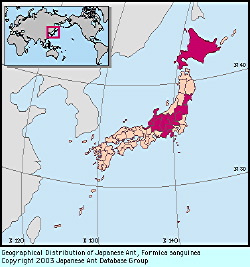
|
species
|
Formica sanguinea
|
 |
Japanese Name
|
Akayama-ari
|
Original Reference
|
|
Latreille, P.A. (1798) Essai sur l'Histoire des Fourmis de la France: 50 pp. Brive.
|
Synonym
|
|
Formica (Raptiformica) sanguinea: Forel, 1913,
Formica dominula Nylander, 1846,
Formica sanguinea subsp. arenicola Kuznetsov-Ugamksy, 1928,
Formica (Raptiformica) sanguinea var. borea Santschi, 1925,
Formica (Raptiformica) sanguinea var. clarior Ruzsky, 1905,
Formica sanguinea var. fusciceps Emery, 1895,
Formica sanguinea var. flavorubra Forel, 1909,
|
Description
|
|
Total length of workers around 6 - 7 mm. Head dark red to black; mesosoma, petiole and legs red; gaster black. Dully shining. This species is distinguished from others in Formica by the median anterior border of its clypeus being concave. The body has only a few erect setae. Males of F. sanguinea are distinguishable from those of other Formica species by their mandibular dentition (the masticatory border has 5 or more prominent denticles) and concave median anterior clypeal border.
|
Remarks
|
|
F. sanguinea does not build mounds. It is sometimes found in independent nests, but its colonies frequently assemble mixed nests by raiding one or two species from a set comprising F. japonica, F. lemani, F. candida, and F. hayashi. Hayashida (1966) observed sanguinea attacking Myrmica yessensis and stealing its larvae. Nuptial flights occur from July to August. The southernmost known locality in Honshu is Mt. Fuji.
|
|

Distribution
|
|
Hokkaido, Honshu (the central part and northwards); northeast Mainland China, Sakhalin, Korean Peninsula, central Eurasia and northwards.
|
|
References
|
|
- Forel, A. 1913. Notes sur quelques Formica. Ann. Soc. Entomol. Belg., 57: 360-361.
- Additamentum adnotationum in monographiam formicarum borealium Europae. Acta Societatis Scientiarum Fennicae 2: 1041-1062.
- Kuznetsov-Ugamsky, N. N. 1928. Ants of the South Ussuri territory. [In Russian]. Zap. Gos. Geogr. Obshch., 1928: 1-47.
- Santschi, F. 1925. Fourmis d'Espagne et autres esp?ces pal?arctiques (Hymenopt.). EOS Rev. Esp. Entomol., 1: 339-360.
- Ruzsky, M. 1905. Muraviy Rossii (Formicariae Imperii Rossici). Sistematika, geografia i dannyie po biologii russkikh muraviev. Chast pervaya. Tr. Obshch. Estestvoispyt. Imp. Kazan. Univ., 38 (4-6): 1-800.
- Emery, C. 1895. Beitr?ge zur Kenntniss der nordamerikanischen Ameisenfauna. (Schluss). Zool. Jahrb. Abt. Syst. Geogr. Biol. Tiere, 8: 257-360.
- Forel, A. 1909. Fourmis d'Espagne r?colt?es par M. O. Vogt et Mme C?cile Vogt, Docteurs en m?decine. Ann. Soc. Entomol. Belg., 53: 103-106.
- Hayashida, K. (1966). Notes on the symbiotic ants of Formica sanguinea Latreille. . Ari, (4), 2-4. .
|
Editor
|
|
Original text by Rikio Sonobe and Keiichi Onoyama. English translation by Keiichi Onoyama, edited by Robert W. Taylor. Revised by Masashi Yoshimura.
|
|